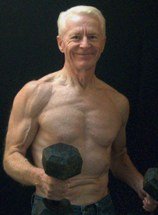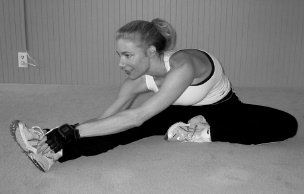
In today's June 1, 2010 newsletter . . .
- Stretching
- The Deck of Cards Workout
Stretching
Stretching has two primary purposes. The first is to increase or retain flexibility and range of motion. The second is to relax your mind and body following a workout. Many trainees shortchange themselves by not taking time to stretch and relax after training. I think that is a mistake. Five or 10 minutes invested in calming your mind and body after a workout is time well spent.
Here are my thoughts on stretching:
- You do not need to be a contortionist to reap the benefits of stretching. In fact, striving for “loose joints” may increase the chances of injury in some athletics.
- Practice dynamic or static stretching. To simplify those terms, dynamic stretching means there is more movement involved, such as in Tai Chi, Pilates, and some forms of yoga. Static stretching refers to the stretch-and-hold types, as in most yoga practices.
- The third form, ballistic stretching, is characterized by rapid and sometimes jerky or bouncy movements. It is not appropriate for a cooling off period following a workout.
 There are many good ways of stretching. The stretches I like are a mixture of movements I’ve learned through weight training, martial arts, and QiGong (pronounced chee-kung). Certainly, there are dozens of other fine stretches you may want to use. Yoga or Pilates classes are good places to learn them.
There are many good ways of stretching. The stretches I like are a mixture of movements I’ve learned through weight training, martial arts, and QiGong (pronounced chee-kung). Certainly, there are dozens of other fine stretches you may want to use. Yoga or Pilates classes are good places to learn them.
Tips on affective stretching
Whatever stretches you prefer, do not force your stretching. Relax into a stretch. That means go only to the edge of discomfort. Then back off just a bit and hold there for a moment, allowing your body to relax. Be soft. By not forcing yourself to go further, your muscles will relax and you will find that you can — softly — move further into your stretch than you thought possible. Now hold 10 or 15 seconds.
Calm your mind and relax your body by focusing on your breathing, by softly inhaling and exhaling from deep within. You’ve had a workout. Now it is time to slow that revved-up engine. It’s time to stretch and relax.

The Deck of Cards Workout
I love the pure grit of this workout. Still, I don’t do it very often because at my age it would wear me down if it was a part of my weekly training cycle. There are ways to tone it down (I’ll explain how later). But when I do it, it is mainly to test myself. I use a stopwatch and give it about all I’ve got. If you are young and tough enough to weave the Deck of Cards Workout into your weekly workout cycle, you will get combat hard and super-fit at warp speed.
I also wish I could say I thought up the workout, but I can’t. The story goes that many years ago the famous American wrestler Karl Gotch introduced it to Japanese wrestlers and judoka to get them in shape fast. They still use it today, I'm told. Here's how it works in the basic Japanese form.
Get a deck of cards. Assign all the black cards to push-ups, and the red cards to squats. Assign face cards a value of 10. Aces are 11. Jokers in the deck are optional. If you use them, assign them an exercise and 15, 20, 25 or even 30 reps.
Now shuffle the deck and draw a card. Let's say it's a red 7. So you do 7 squats. Draw another card, and say it's a black 9. Now you do 9 push-ups. Keep moving this way until you've gone through the entire deck, which takes about 30-minutes or less for well-conditioned athletes. The idea is to go through the deck as fast as you can.
You don’t have to do it in the pure Japanese form. It’s okay to be creative. Personally, I like assigning 4 exercises instead of 2, which I think provides more balance for a full-body workout. For example, I have done bodyweight squats (for hearts), push-ups (for diamonds), squat-thrusts/aka burpees (spades), and sit-ups (clubs). Full-scale masochists may up the intensity even further by doubling the number of any one of the exercises the card value calls for. You decide before you start.
Beginners can do the routine if they adjust the intensity and duration by using only the 2s, 3s, 4s, and 5s in the deck, for example. They can gradually “up the ante,” so to speak, by adding additional card numbers as their fitness improves, until finally they are using the whole deck. Just keep in mind this is tough stuff. Senior beginners should approach it with caution and common sense.
You've probably heard about the tremendous benefits of weight training and how you can retain -- or even reclaim -- the attributes of youth . . . Discover the way with . . .
Gray Iron: A Fitness Guide for Senior Men and Women
Newsletter Policy
The Gray Iron Fitness Newsletter is a free publication sent twice monthly to subscribers. The purpose is to provide honest and realistic fitness information for people age 50 and above.
I have never been paid or received compensation of any kind to write a positive review or endorse a product. If I say that I personally use a product or service, it is because I find value in it and have paid for it with my own money.
Like newspapers, magazines and television, the newsletter and web site contain advertising and some affiliate marketing links. I receive a commission when people buy the advertised products or services.
The newsletter and web site provide information to help users establish and maintain a fitness lifestyle. But fitness information is not the same as fitness advice, which is the application of exercise and dietary practices to an individual's specific circumstances. Therefore, always consult with your physician for assurance that fitness information, and your interpretation of it, is appropriate for you. Your comments or questions are always appreciated. Sincerely,
Logan Franklin
The Gray Iron Fitness Newsletter
www.senior-exercise-central.com
|



